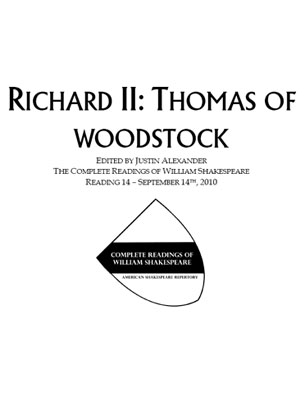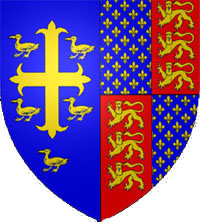 As I’ve mentioned before, the manuscript for Richard II: Thomas of Woodstock has seen better days. Torn pages and missing words are damaging enough, but perhaps the most devastating loss to the play is its finale: At least one full leaf is missing at the end of the play, taking with it at least 120 lines (based on the number of lines per leaf in the rest of the manuscript). It’s unlikely that we are missing more than one or two leaves, as the play is already rather long at 2,989 lines and is clearly heading towards a conclusion.
As I’ve mentioned before, the manuscript for Richard II: Thomas of Woodstock has seen better days. Torn pages and missing words are damaging enough, but perhaps the most devastating loss to the play is its finale: At least one full leaf is missing at the end of the play, taking with it at least 120 lines (based on the number of lines per leaf in the rest of the manuscript). It’s unlikely that we are missing more than one or two leaves, as the play is already rather long at 2,989 lines and is clearly heading towards a conclusion.
The ending of a play, of course, contains the culmination of its plot, theme, and characters. Therefore, in order to discuss or analyze Richard II: Thomas of Woodstock, one must hypothesize the nature of its ending. (If Godot shows up, Waiting for Godot looks like a very different play.) And if one is going to perform it, of course, a conclusion of some sort must be written.
It is perhaps unsurprising to discover that the hypothetical ending of the play has become a crucible for the authorship debate: Write the ending one way, and it strengthens the play’s ties to Shakespeare’s Richard II. Write it a different way and the plays become completely incompatible.
CONCLUDING THE PLOT
Much like the authorship debate itself, there are basically two possibilities for the ending of Richard II: Thomas of Woodstock:
First, the play could be viewed as a complete conflation of Richard’s reign: The cronies of Richard’s final crisis (Bushy, Bagot, Scroop, and Green) are transplanted into Richard’s first crisis (which historically featured an entirely different set of nobles). Gloucester’s death, which in real life took place between the two crises, is dramatically shifted to the culmination of the first. But instead of being resolved in a series of primarily political maneuvers, this crisis is instead resolved on the field of battle in the fashion of the second crisis.
Theoretically one could argue that this is not a prequel to Shakespeare’s Richard II, but rather supercedes it entirely: All one needs to do is provide an ending in which Richard abdicates his throne in order to complete the play’s masterful blending of every crisis in Richard’s reign into a single, unified narrative.
This theory runs into a rather significant stumbling block, however, when one notices that Henry Bolingbroke — Richard’s replacement and the future Henry IV — is conspicuously missing from the play. While it’s impossible to completely rule out a last minute revelation of the heir apparent (akin to Henry VII in Richard III or Fortinbras in Hamlet), it’s rather difficult to imagine how the play would simultaneously remove Bolingbroke’s father (the Duke of Lancaster), who has also been left rather inconveniently alive.
Thus we are forced to turn to the second possibility, in which Richard’s first deposition is carried out: Stripped of his friends and with their tyrannies revoked, Richard is allowed to keep his throne. Much like the historical record, there is a return to a sort of status quo, allowing for a relatively seamless continuity with the beginning of Richard II.
In addition to Richard’s fate, there’s the question of how the issue of Woodstock’s murder was to be resolved. It has been hypothesized that Lapoole’s entrance as a prisoner at the top of the scene must presage an ultimate revelation of Woodstock’s fate, but this isn’t necessarily true: Lapoole may merely be rounding out the crowd of Richard’s cronies who have been captured during the battle (and destined to be sentenced during the course of the scene). If the play is connected to Richard II, it’s notable that while Gloucester’s death is known at the beginning of that play, even Lancaster and York are left to speculate on the king’s guilt in the matter.
CONCLUDING THE CHARACTERS
Tying off the loose ends of the plot in R2: Woodstock is largely a matter of shuffling historical necessity and guessing which bits the author intended to include. More difficult to guess are the particular conclusions of each character’s arc, since each character — although largely drawn from the historical record — is nevertheless the unique creation of the author’s genius.
Of course, not every character in a drama is necessarily worthy of equal attention. Therefore, one needs to choose which characters are to be given the spotlight’s focus. In the case of R2: Woodstock, my best guess is that this focus belongs to Nimble and Tresilian (who have been the focus of the play’s B-plot), Richard (by necessity of his deposition if nothing else), and the king’s surviving uncles (partly as a continuation of Woodstock’s important legacy within he play).
As for Nimble and Tresilian, the thrust of their arc has already been initiated in Act 5, Scene 5, and is being drawn to a close when the script abruptly cuts off. It’s not difficult, therefore, to round off an ending in which the servant becomes the master (completing a cycle of class inversion found throughout the play) and Tresilian is brought to justice for his tricks in the culmination of a final trick played by Nimble.
Next we turn to Richard, who is most likely brought onstage as a captive by the Duke of York (who is conspicuously absent at the beginning of the final scene). Is he to be humbled like Tresilian? Perhaps. But if Richard is to end with his crown intact, it may make more sense to draw a contrast between his fate and that of his false judge. Let us instead suppose a Richard who, out of his need to find some strength to rely on, turns to the surety of his divine right to the throne: This harrowing experience can actually serve to strengthen and purify that belief, already found as a subtext throughout R2: Woodstock, into the central tenet of his existence (and thus setting the stage for Richard II).
Finally we come to the dukes of York and Lancaster. Throughout the play they have largely acted in concert as “headstrong uncles to the gentle king” (as Greene describes them in 1.2), but there have also been subtle divisions drawn between their characters: The “relenting Duke of York” (2.1) being contrasted against a Lancaster who is frequently “past all patience” (1.1).
Let’s suppose that in this final scene this division between brothers is brought into the open, perhaps driven by their different responses to Woodstock’s death. Lancaster, who had already sworn to “call King Richard to a strict account” (5.3) can follow their initial inclination to its extreme and depose Richard. York, on the other hand, can learn from Woodstock’s counsel and follow his example of temperance and patience, thus turning Woodstock’s death into a final sacrifice in accordance with Woodstock’s final prayer.
(And this, too, transitions the characters naturally to the beginning of Richard II.)
CONCLUDING THE THEMES
Even moreso than with plot or character, attempting to provide a thematic conclusion for the play bears the risk of stamping it with one’s own interpretation of the drama. Thus I have chosen to walk carefully, preferring to include thematic elements without necessarily seeking to summarize or pass judgment on them.
Occasionally, however, boldness is called for. In particular, I have chosen to take up key themes of Richard II. Many of these themes have already been highlighted in Richard II: Thomas of Woodstock, but others which have not previously been present in the play are established as the transformation of one theme into another.
Thus, for example, a king who has been vain turns reflective. And whereas in the aftermath of Anne a Beame’s death Richard says of himself, “My wounds are inward, inward burn my woe.” In the face of fresher losses, we find that his woe has consumed entirely, transforming him into a hollow king.
Have I overstepped scholastic certainty? Of course. But the ending of a play should never be completely predictable. So if we limit ourselves to providing an ending which does nothing that is not already contained in the play as it exists, we would confine ourselves to an artistically and dramatically unfulfilling conclusion. In seeking to push the boundaries of the play beyond the known limitation of its final, broken page, aiming towards Richard II as lodestar provides at least some guidance where we might otherwise find ourselves stumbling blindly in the dark.
THE SCRIPT ADDENDUM
The ASR scripts of the play have been updated to include the ending as it was performed during the Complete Readings of William Shakespeare. If you’re interested in reading the new ending by itself, a separate PDF link has been included below.
Permission to use this additional material in print or production is freely granted as long as the following notice is included on either (a) the title page or cover of the printed publication or (b) the cover of the production’s program, website, and any posters, postcards, or similar advertising:
New Ending Written by Justin Alexander
https://www.thealexandrian.net
Originally Produced by the
American Shakespeare Repertory
http://www.american-shakespeare.com
RICHARD II: THOMAS OF WOODSTOCK – THE NEW ENDING
RICHARD II: THOMAS OF WOODSTOCK – FULL SCRIPT
RICHARD II: THOMAS OF WOODSTOCK – CONFLATED SCRIPT
Originally posted on September 19th, 2010.

 Every piece of evidence surrounding the authorship of Richard II: Thomas of Woodstock points to one of two truths:
Every piece of evidence surrounding the authorship of Richard II: Thomas of Woodstock points to one of two truths:









